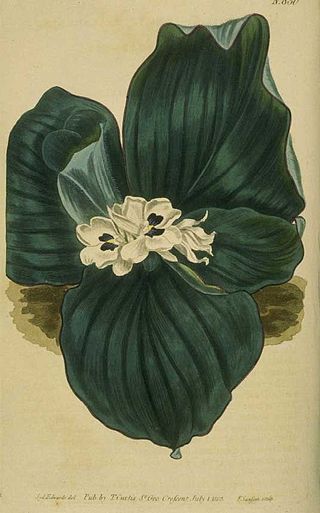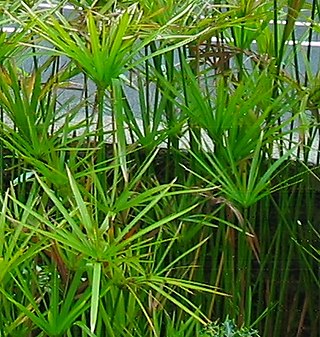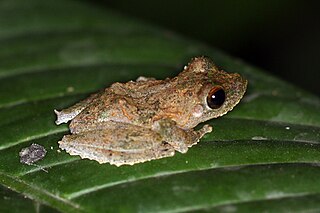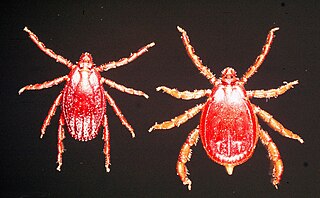
Galangal is a common name for several tropical rhizomatous spices.

Cyperus papyrus, better known by the common names papyrus, papyrus sedge, paper reed, Indian matting plant, or Nile grass, is a species of aquatic flowering plant belonging to the sedge family Cyperaceae. It is a tender herbaceous perennial, native to Africa, and forms tall stands of reed-like swamp vegetation in shallow water.

The Cyperaceae are a family of graminoid (grass-like), monocotyledonous flowering plants known as sedges. The family is large, with some 5,500 known species described in about 90 genera, the largest being the "true sedges" genus Carex with over 2,000 species.

Cyperus is a large genus of about 700 species of sedges, distributed throughout all continents in both tropical and temperate regions.

Cyperus rotundus is a species of sedge (Cyperaceae) native to Africa, southern and central Europe, and southern Asia. The word cyperus derives from the Greek κύπερος, kyperos, and rotundus is from Latin, meaning "round". The earliest attested form of the word cyperus is the Mycenaean Greek 𐀓𐀞𐀫, ku-pa-ro, written in Linear B syllabic script.

Cyperus alternifolius, the umbrella papyrus, umbrella sedge or umbrella palm, is a grass-like plant in the large genus Cyperus of the sedge family Cyperaceae. The plant is native to West Africa, Madagascar and the Arabian Peninsula, but widely distributed throughout the world. It has gained the Royal Horticultural Society's Award of Garden Merit. The subspecies Cyperus alternifolius ssp. flabelliformis is also known as Cyperus involucratusRottb..
Pristimantis appendiculatus, the Pinocchio rainfrog, is a species of frog in the family Strabomantidae. It is found on the Pacific slopes of the Andes in Ecuador and extreme southern Colombia.

The frilled tree frog, rough-armed tree frog, or Southeast Asian tree frog is a species of frog in the family Rhacophoridae found in Brunei, Cambodia, India, Indonesia, Malaysia, Myanmar, the Philippines, Thailand, and Vietnam. Its natural habitats are subtropical or tropical moist lowland forest, subtropical or tropical swamps, subtropical or tropical moist shrubland, rivers, swamps, freshwater marshes, and intermittent freshwater marshes. It is threatened by habitat loss.
Kurixalus verrucosus is a species of frog in the family Rhacophoridae found in Myanmar, Thailand, China, and Vietnam. In the past, it has been considered synonym of Rhacophorus appendiculatus, which, together with other confusion regarding the identity of this species, makes interpreting older literature difficult. Its natural habitats are subtropical or tropical moist lowland forests, subtropical or tropical moist montane forests, rivers, and intermittent rivers. It is threatened by habitat loss.

Cyperus eragrostis is a species of sedge known by several common names, including tall flatsedge, nutgrass, tall nutgrass, umbrella sedge, chufa, Earth almond, zula nuts, edible galingale and pale galingale.

Cyperus fuscus is a species of sedge known by the common name brown galingale, or brown flatsedge. This plant is native to much of Europe, Asia and North Africa from England, Portugal and Morocco east to China and Thailand. It is an introduced species in North America, where it is naturalized in widely scattered locations in the United States and Canada.

Cyperus scariosus is a perennial herbaceous plant from Australia and New Guinea.

Butyriboletus appendiculatus is an edible pored mushroom that grows under oaks and other broad leaved trees such as beech. It is commonly known as the butter bolete. It often grows in large colonies beneath the oak trees, and is frequently found cohabiting with old oaks in ancient woodland. It is relatively rare in Britain. Its stipe and pores are often bright yellow and its flesh stains bright blue when cut or bruised.

Butyriboletus is a genus of fungi in the family Boletaceae. The genus was circumscribed in 2014 by mycologists David Arora and Jonathan L. Frank to accommodate "butter bolete" species that were shown by molecular analysis to be phylogenetically distinct from Boletus. Butyriboletus contains 24 ectomycorrhizal species found in Asia, Europe, North America and north Africa.
Aspergillus appendiculatus is a species of fungus in the genus Aspergillus. It is from the Aspergillus section. The species was first described in 1975. It has been reported to produce asperflavin, auroglaucin, bisanthrons, dihydroauroglaucin, echinulins, emodin, erythroglaucin, flavoglaucin, isoechinulins, neoechinulins, physcion, questin, questinol, tetracyclic, and tetrahydroauroglaucin.

Cyperus compressus, commonly known as annual sedge, is a sedge of the family Cyperaceae that has a wide distribution throughout countries with warmer climates. It is found in tropical areas of Africa, Asia and the Americas.

Rhipicephalus appendiculatus, the brown ear tick, is a hard tick found in Africa where it spreads the parasite Theileria parva, the cause of East Coast fever in cattle. The tick has a three-host life-cycle, spending around 10% of its life feeding on animals. The most common host species include buffalo, cattle, and large antelope, but R. appendiculatus is also found on other animals, such as hares, dogs, and warthogs.

Cyperus flavescens, commonly known as the yellow flatsedge, is a species of flowering plant belonging to the family Cyperaceae.













